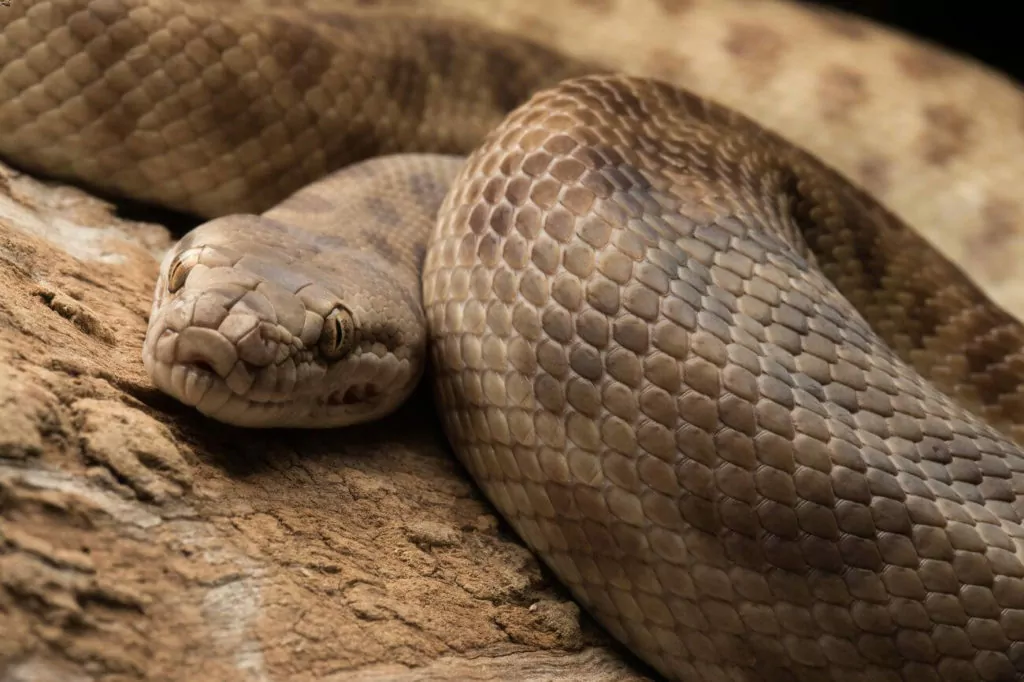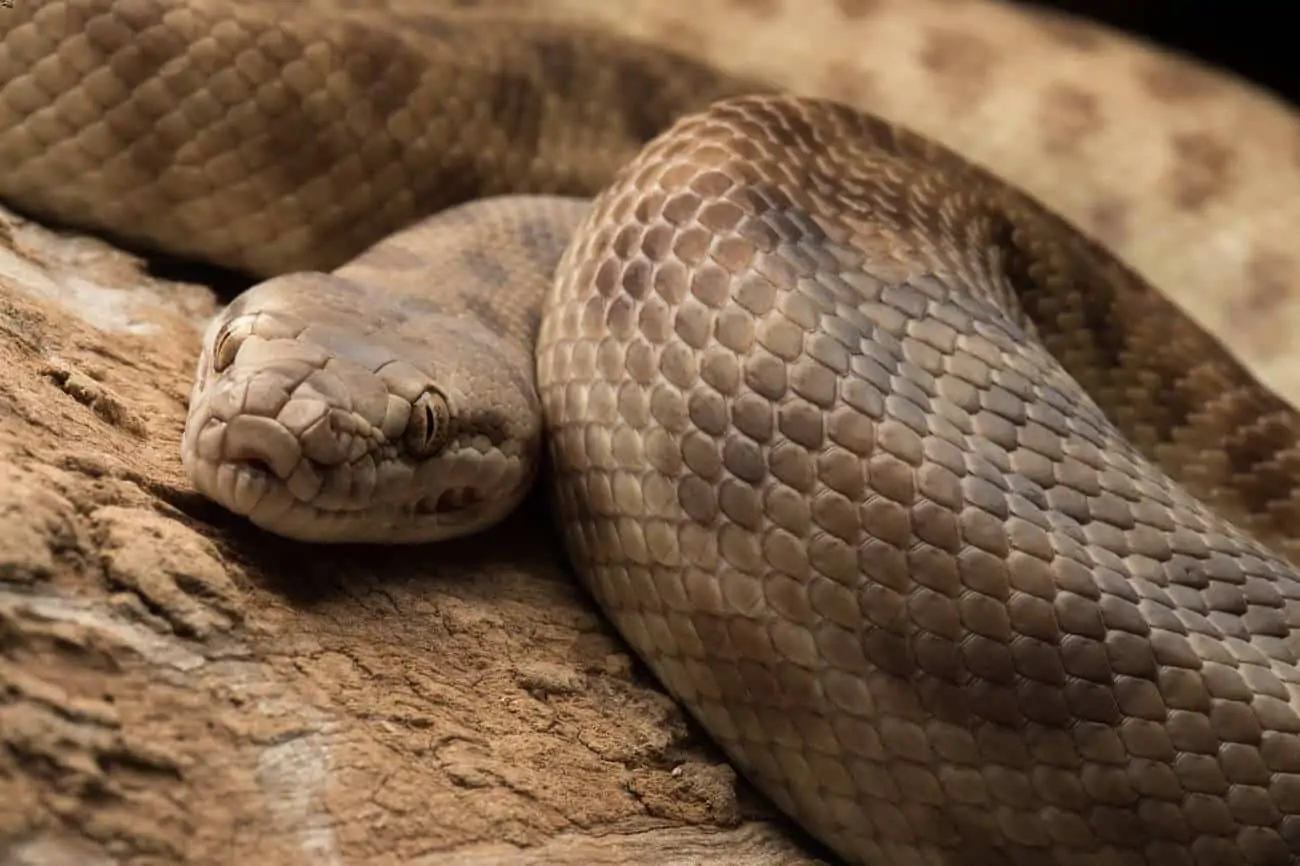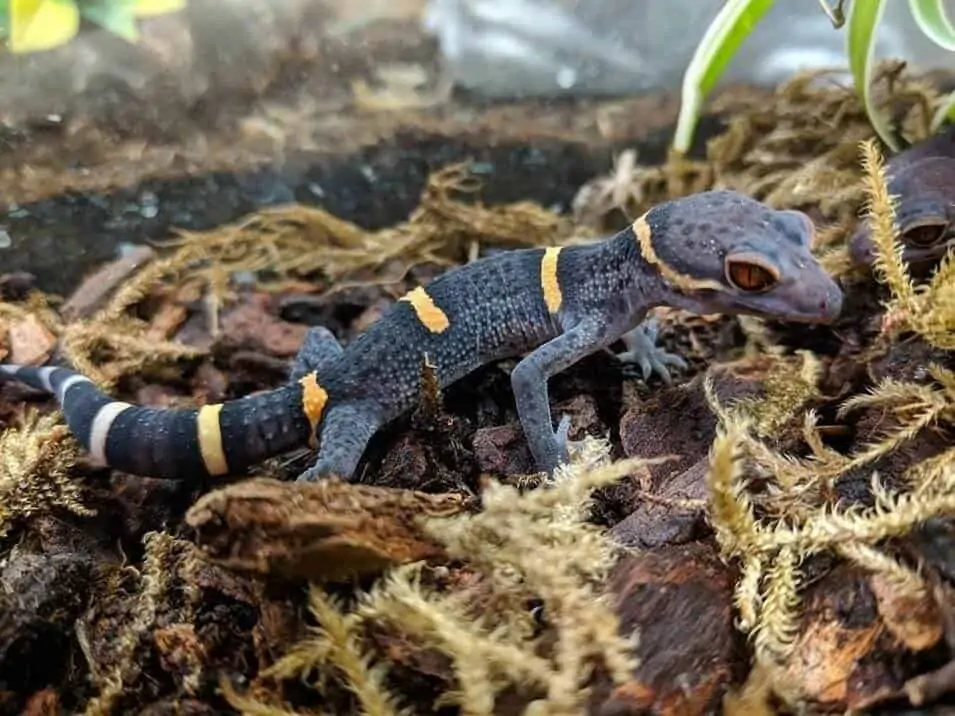The Children’s python is a rather underrated pet snake that we’ve been a fan of for years. With their mellow temperament and low-maintenance care requirements, this is a species that’s great for beginners.
But before you go out and purchase one for yourself, it’s important to do your homework. Having a strong understanding of what these snakes need to thrive goes a long way!
This guide will teach you all about Children’s python care. From their enclosure setup to their size, this guide has it all!
Table of Contents
Species Summary
Children’s python (Antaresia childreni) is a non-venomous snake that comes from areas in northern Australia.
The name of this snake is not meant to imply that it is a good snake for kids. It’s named after John George Children, the guy who discovered it in the 1800’s.
Children’s python has a pretty calm demeanor, and many reptile enthusiasts recommend this python as a good pet snake for beginners. That’s actually how we were introduced to this species back in the day!
Appearance & Colors
The Children’s python is quite small compared to other constrictors and is fairly slim in build. It’s coloration is perfect for blending into natural surroundings with a reddish brown body and darker marks that kind of resemble leaves.

These mark clusters aren’t large and are evenly spaced from head to tail. It creates a very interesting effect when these snakes move!
Expert Tip: Younger Children’s pythons tend to have a brighter skin that darkens as it grows and sheds.
Average Children’s Python Size
The typical Children’s python size is between three and four feet in length. This is quite different from what many people think of pythons (they usually imagine giant species).
That’s one of the reasons why Children’s python care is often recommended for beginner snake owners. Their size is very manageable, and they don’t require a huge enclosure.
Lifespan
The average Children’s python lifespan can be up to 30 years in captivity. That makes this species a great choice for anyone who wants a pet to enjoy for many years.
With that being said, you should think about what this means. A snake with such a long lifespan may not be for everyone, so it’s a good idea to really decide if you’re ready to take on such a long commitment of care.
Children’s Python Care
Children’s python care is not particularly difficult if you have the right information. However, you will still need to be dedicated to its daily maintenance and dietary requirements.
On paper, caring for a Children’s python is really quite straightforward. Like all pet reptiles, it’s going to need the right enclosure, regulated temperature and humidity and a healthy diet.
Add into all that a healthy dose of patience and respect, and you should expect to have a happy and healthy pet!
Enclosure Size
Because the enclosure is where your snake may spend the next 30 years of its life, you should try to make it a place of comfort, security and happiness.
The first thing to do is to decide on a size and type of enclosure.
As far as the size of the enclosure goes, your adult Children’s python will do fine in a tank that is around 3 by 2 by 2 feet. You can go bigger if you like, but this size is plenty. If you are getting a hatchling, then a ten gallon tank is a good size to start out with.
When it comes to materials, various kinds can be used. From glass tanks and plastic bins to snake racks and gorgeous wooden vivariums, your pet will be quite comfortable.
They each have their own advantages and disadvantages, so just do what works best for you. We tend to lean towards the wooden enclosures because they have a nice natural look, and they tend to hold in heat better than other kinds.
Expert Tip: Glass tanks are fine as well, but your Children’s python may feel more nervous in a glass tank. Whichever kind you choose, just make sure that it has a very secure top and has lots of cross ventilation.
Habitat Setup
There are several definitions of what a habitat is. One definition says that a habitat is where something has all of its environmental needs met. Another definition, and one to think about when you are designing your snake’s habitat, is that it’s a place where an organism makes its home.
When you are working on the habitat setup for your Children’s python, try to create a space that feels most like its home. The range of this snake spans several different habitats like grasslands, wetlands, shrubland and forest, so see if you can incorporate aspects of these habitats into the enclosure.

It’s important to start out with a good substrate, and there are several acceptable options. Aspen bark, beech chippings or a pre-made reptile substrate all work well. Just stay away from cedar, pine or eucalyptus shavings. No matter which kind of substrate you choose, you’ll need to spot clean it daily and change it out often.
After putting in the substrate, you can now gather and arrange all of the enclosure enhancements that will take your snake’s home to the next level.
These snakes like to hide, so having places to hide on both the warm and cool side of the enclosure is very important. You can use logs, rocks, reptile hides or even small wooden boxes. Start off with something, and if it doesn’t seem to work, change it out for something else.
These pythons like to climb and explore their surroundings, so having some branches and plants around the enclosure is important. Your snake will take some time to adjust to its new living space, so you’ll be able to see what works and what doesn’t.
Temperature & Lighting
Like all reptiles, the Children’s python is ectothermic. This just means that it can’t regulate its own body temperature, and it needs to physically change locations to warm up or cool off.
In your enclosure, you’ll need to set up what is called a temperature gradient. This is very easy to do, and it basically involves designating one end of the enclosure as a warmer, basking zone and the other side as the cool-down spot.
Choose a side to be the basking side, and that’s where you are going to place your basking lamp and an under-the-tank heating pad. This area should remain between 85 and 90 degrees Fahrenheit at all times.
The other side (the cooler side) should stay around 78 to 80 degrees Fahrenheit. If the temperature goes down a few degrees at night, that’s perfectly fine.
Expert Tip: Some reptiles require a steady source of supplemental UVB or UVA lighting. Children’s pythons don’t technically need this kind of lighting, but you can add it if you wish. A fluorescent light works great, so don’t go crazy with expensive set ups.
Humidity
This is one of the most important aspects of Children’s python care. These snakes need a humidity level of around 50 percent.
If the humidity drops below this level, then your pet could have problems when it’s time to shed (and potentially other health complications). Hand mist the enclosure a couple of times a day, always keep a fresh source of water in the enclosure and use a good substrate.
Also, invest in a reliable and accurate hygrometer for checking the humidity in their enclosure. Inaccurate readings from poorly-made hygrometers cause problems for many owners and their pets.
Water
Children’s pythons are simple when it comes to water. As long as you provide fresh, clean water in a bowl that’s big enough for the snake to soak in, that should be fine.
Just make sure to change the water a couple times a day, and really scrub the water bowl once a week. A dirty bowl will quickly accumulate bacteria and lead to health issues for these reptiles.
Food & Diet
In captivity, a Children’s python will eat either rats or mice. There is some debate as to whether the prey should be live or pre-killed and frozen. Many opt for the frozen kind of food because live prey can actually attack and hurt your snake.
If you have a young python, give it a pinky mouse about once a week. Once it’s an adult, it can be given a large mouse or rat every few weeks.
Moving a Children’s python to another enclosure before it eats is a matter of choice. Some owners say that they do just fine eating in their own enclosure, and others say that they may become more apt to bite due to a feeding response. As with all snake matters, do what feels right for your pet.
Expert Tip: Remember to always leave your snake alone for 24 hours after it has eaten. If you handle the python too soon, it will probably regurgitate what it just ate.
Potential Health Concerns
Children’s pythons are generally healthy, but there are some red flags to watch out for.
If you see your snake spending extra time in its water bowl and you notice little black dots floating in the water, your snake probably has an infestation of mites. Snake mites are a real problem for snakes, and you will need to take your Children’s python to the vet for treatment.
These snakes are also subject to respiratory infections (like many reptiles). Keep the enclosure clean, provide lots of ventilation and keep the humidity and temperature levels where they should be, and you should be able to avoid a respiratory infection.
Fortunately, most of the common health issues can be prevented with great care. Play by the book and give your pet the attention and time it needs, and they’ll likely stay quite healthy.
Behavior & Temperament
The Children’s python is a snake with a nice, even temperament. It rarely bites, and if it does, it is usually because the python mistakes the caretaker’s hand for food.
With time and patience it’s possible for these snakes to become quite comfortable with handling. However, you should still keep handling to a minimum.
Expert Tip: Even though this is a nocturnal species, you’ll still see it moving about the enclosure during the day (which makes them fun to observe). As it goes about its daily business, you will find this snake basking, climbing, exploring or resting!
Handling Them
With some training, many owners find that the Children’s python is easy to handle. However, it’s worth pointing out that this snake does not enjoy being touched on the head.
As long as you stay away from this area and handle them properly (support the snake with two hands and hold it gently), you shouldn’t have any problems.
Conclusion
We hope you found this care sheet about Children’s pythons useful, and plan on using it to help your pet thrive. These snakes are wonderful pets that we recommend to pretty much anyone!
If there are any additional facts you think we should include (or you simply want to reach out with a question), don’t be shy! One of the best things about this site is our ability to interact and meet our readers.



